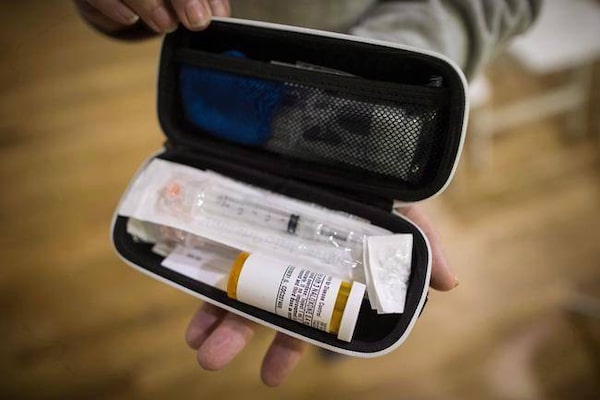
Deborah Buchanan displays the naloxone kit she received after learning how to respond to an overdose during a community meeting in Kitsilano, in Vancouver, B.C., on Monday Nov. 13, 2017.The Canadian Press
Men in the construction trades are one of the key groups of people dying of drug overdoses in B.C., prompting a top health official in Vancouver to suggest policy makers may need to find different ways to tackle the opioid crisis.
Dr. Patricia Daly, the chief medical health officer for Vancouver Coastal Health, was updating Vancouver’s new city council on Tuesday on the latest information about opioids. Statistics have already shown that it is primarily men between the ages of 19 to 55 who are dying of overdoses in B.C.’s current crisis. She noted data have found construction workers may be more likely than other groups to take drugs to deal with pain from workplace injuries.
“People often think it’s homeless people who are dying,” Dr. Daly told council. “This is new to me. And we’re wondering does it mean we have to do new work?”
For example, she questioned whether company policies meant to discourage drug use may instead be inhibiting workers from getting treatment.
“They will think they can’t go on opioid [substitution] treatment because it will show up in a drug test,” Dr. Daly said. Their concern might be that an opioid substitution such as methadone could indicate to an employer a long-term drug problem, so instead, a worker may prefer to use opioids sporadically or use other tactics to avoid detection at work.
There were about 225,000 people employed in B.C.’s construction industry in 2017, according to statistics compiled by the B.C. Construction Trades Association.
Dr. Daly also noted that B.C.’s epidemic is not likely to soon run its course.
She said provincial statistics show there are 55,000 people who have been diagnosed as being at risk of overdosing because they are drug users. And there are countless thousands of others who have never been diagnosed.
“That is an incredibly large number of people. That means a lot of people could be dying,” Dr. Daly said.
The one somewhat positive note in Dr. Daly’s presentation was her statement that the death rate isn’t going up any more in Vancouver, as it has been the past few years.
There were 367 deaths from overdoses last year in the city of Vancouver, up from 234 the year before and 138 the year before that. There have been 304 confirmed deaths up to Nov. 4 this year in Vancouver. The total in B.C. for 2017 was 1,450 deaths.
As well, she said there would have been two and a half times as many deaths if there hadn’t been a widespread turn to providing naloxone, which reverses overdose effects, and the creation of overdose-prevention sites.
In response to questions from the city’s new councillors about solutions to the crisis, Dr. Daly said the best strategies would be to address some of the root causes of drug use: lack of housing, food, access to health services and addiction treatment.
In particular, she said the city could help reduce deaths by adding health centres in neighbourhoods other than in the Downtown Eastside.
Statistics show that one in 10 people who overdose in some of the city’s single-family neighbourhoods ends up dying, while in the Downtown Eastside, only one in 26 overdoses is fatal.
 Frances Bula
Frances Bula